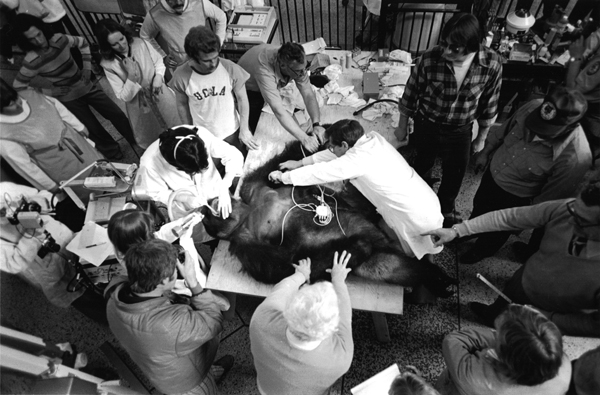home > cflow journal > issues > 2013 > 2013-2
cflow journal - issue 2013-2
Creative Assemblages – When aesthetics meet the economy or what do they have in Common?
Curatorial Text: Creative Assemblages – When aesthetics meet the economy or what do they have in Common?
With the participation of: Benjamin Egger, Petra Elena Köhle & Nicolas Vermot Petit-Outhenin, Ferhat Özgür, Elodie Pong, Roee Rosen, Riikka Tauriainen, Borjana Ventzislavova.
an international group exhibition at Siemens Sanat, İstanbul, curated by Dimitrina Sevova, co-curated Mürteza Fidan and Melih T. Görgün.
Opening: Tuesday, 5 February 2013, 19:00.
Performances by Riikka Tauriainen and Petra Elena Köhle & Nicolas Vermot Petit-Outhenin: Wednesday, 6 February starting at 18:30.

Benjamin Egger, Forced Trauma, "Wallpaper: Detroit Free Press, 22 April 1979", 2012
The exhibition unfolds in the border zone in-between the ruins of the image, its regime of re-presentation and re-production, of text and texture, in-between semiotic and semantic, in-between grammar and experience in the metabolism of exchange in social production. It deploys and enacts an exhibition display as a territory of performative assemblages of re-used ready-made opinions, estranged from imaginary machines, from mass mythologies and their mediatic regimes as paradigms of the neurotic forms of intense communication and the bio-political embedding of a systematization, stimulation and interiorizing on the basis of algorithmic abstraction. The exhibition asks the viewers to move their view from the imaginary and abstract to the concrete sensual object and aesthetic experience, on the principle of observation, geometrical reasoning and theatricality.
The world and our everyday experience, mental and corporeal, the essence of communication are transformed, fueling extra-economic factors that are inscribed in form of a code in an interior milieu. The coded structures fragmentize into extremely complicated hyper-architectures and accelerate time, pushing everyday life towards invisible processes in an infinite excess of sign circulation. The latter perpetuates a world of synthetic units, simultaneity, synchronization and simulation in real time exploiting the cognitive and sensual. The digital circulation stream of linked automated writing machines and just-in-time inventory systems write our reality and connect dispersed production sites. Their efforts are concentrated on the preservation and stabilization of traces of fluxes rather than on meanings, being-in-common and singular forms of existence. As a result, image production turns into a linguistic procedure in the general flow of semiotic capital with its inherent mobility and the transferability from one recording device to another reading device in a ritournelle of encoding and decoding.
The exhibition explores the possibility of inventing "a complex and explicitly non-essentialist notion of subjectivity" in relation to the destructed image production where the mode of viewing can be perceived as an expanded understanding of economic production (aesthetic, synthetic and libidinal). It brings together seven artistic perspectives to create an open field of assemblages based on appropriation, re-enactment, re-staging and re-working as aesthetic practices in the relation between different economic regimes with their different languages of organization and their entropy, in which the material presence of the image defies the dispersing of image production in a crisis where modes of viewing merge production and consumption. We can even speak of a reversal of the relation between production and consumption, between offer and demand in an economy of knowledge and immaterial labor where psychoanalytic practice and the economic domain overlap in language, cognitive activities, and the production of affects and beliefs.
The art works gathered in the exhibition can be seen as the deterritorialization of art objects for the temporary territorial realization of abstract needs evoking a new materiality and aesthetic sensualism, which can be realized only through the direct experience of the public and the quality of its emotions involved in aesthetic and social productivity. Indeed, the material conditions of the symbolic and of knowledge call forth a new materialism, to be understood as a materiality of causal relations, and bring out new aesthetic and social forms capable of production and exchange of objects of knowledge, visual pleasure and social value as becoming-in-common.
The exhibition inquires into this new mode of existing of the relation in-between materiality and immateriality, which leads to a recomposition of the place of the spectators and the art object and its aura, where the imaginary and the symbolic are realms as real as our authentic emotions and our attention. It is under this influence that artists have completely changed their approach to image production, text and language, as well as to spatio-temporal relations. The exhibition draws on the capacity of this new aesthetic and social regime of art as an autonomous field to elaborate emotionally communicatively connected environments of attraction, conflict, relationships and mental and corporeal energy as a common and singular sensibility. It draws a map of the sensible and the cognitive by means of appropriation as a "multiple becoming" and kindly invites the public to orient themselves in a foggy and flooded time "when a flow becomes a flood." Because in the global economic mobilization of attention we still need memory, history and flesh in the process of formation of the social imaginary. And from here, let us try to move to the concrete sensual object.
(PDF 187KB)